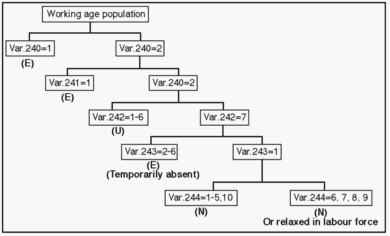
|
||||||||||||||||||||||||||||||||||||||||||||||||||||||||||||||||||||||||||||||||||||||||||||||||||
Appendix A.7Labour Table AppendixComparison with Israeli CBS Labour Force Survey for "Judaea, Samaria, and the Gaza Area".Because of the widespread reference to the Israeli Labour Force survey in discussions about employment in the occupied territories, it may be of interest to discuss the compatibility of concepts and definitions between this survey and the FAFO Living Conditions survey. Even if both surveys are based on the ILO endorsed "labour force framework", they have some differences that are of relevance for comparison of results. This appendix will provide some guidelines for comparison of the two surveys. The discussion will be conducted along comparison of results for the three main labour force groups; "not in the labour force", "employed" and "unemployed".At this stage it may be useful to point to the different purposes of the two surveys to be compared. As a standard "labour force survey", the CBS survey is primarily concerned with measuring labour activity conducted by the Palestinian population in the occupied territories. The FAFO living conditions survey, on the contrary, is at least as interested in documenting non-activity, and the possible reasons for this lack of labour activity. Figure A.7.34 presents how the respondents are ascribed their labour force status in the FAFO survey according to their answers in the employment section of the questionnaire.
Not in Labour Force/
Labour Force Participation
Table A.7.30 Comparative labour force participation rates FAFO 1992 and CBS 1990
Note: The CBS results for the "Occupied Territories" have been taken from two separate sources. The results for Gaza and the West Bank are taken from the CBS "Statistical Abstract of Israel 1991", Table 27.17. The results for "Arab Jerusalem", also presented separately in Table A.7.30, are calculated from The Jerusalem Institute for Israel Studies' "Statistical yearbook of Jerusalem no. 9 - 1990", Tables VII/1 and VII/2. After the war in 1948, Beit Safafa South remained the only area in West-jerusalem with compact Arab settlement. Except for this small area, almost all "Non-Jews" in Jerusalem still live in the eastern part of the city, i.e. in areas covered by the FAFO survey. The Jerusalem Institute for Israel Studies' results for "Non-Jews" in Jerusalem has thus been weighted into the CBS labour statistics for "Judaea, Samaria and Gaza" to construct a CBS estimate parallel to the area covered by the FAFO survey. Labour force membership in the FAFO living conditions survey required, as in the CBS labour force surveys, either at least one hour paid work, or at least 15 hours work in family farm or business, or both in the preceding (determinant) week. All FAFO results concerning under-utilization of labour are based on these definitions. Even if both surveys thus use the same basic definitions from the labour force framework, FAFO numbers systematically exceeds those of the CBS. The 1990 CBS data are based on quarterly interviews, and are thus adjusted for seasonal variations in labour force participation. In the FAFO survey on the contrary, interviewing took place in June, July and August 1992 only. Seasonal variation in labour force participation may thus explain some of the differences between the two surveys. 1990 was deliberately selected as CBS reference year instead of 1991, to reduce the influence of the Gulf war on employment. Still, differences in the political situation, like the reduction of the intensity of the intifada from 1990 to 1992, may have led to increased labour force participation in this time span. Finally, the observed differences between FAFO and CBS labour force participation ratios may also be rooted in the interviewing situation itself: To gain confidence with female respondents, FAFO used female interviewer pairs to interview women. The fact that the relative differences in labour force participation ratios between the two surveys are greater for women than for men, could be an indication of greater confidence among respondents with FAFO enumerators. Even if the FAFO survey was carefully designed to obtain more accurate statistics on women's activities, we still feel the coverage of unpaid female economic activities can be further improved. Thus, there is, no doubt, scope for future innovative research to be conducted in this field.
Unemployed Persons Table A.7.31 Comparison of unemployment rates in the FAFO 1992 and CBS 1990 surveys
The FAFO survey measures higher unemployment ratios among women, and for Gaza than CBS. The higher unemployment ratio for women in the FAFO survey may be due to the inclusion of Arab Jerusalem in this survey. A possible explanation for the difference for male unemployment in Gaza is differences in the political situation between 1989 and 1992. At the time of interviewing in the FAFO survey, new restrictions on employment in Israel (age limits on entry, new permissions, e.t.c.) had recently been introduced, obstructing several Gaza workers from access to their usual employment in Israel.
Employed Persons
Figure A.7.35 Distribution of employed persons in the FAFO and CBS surveys
The distribution of employed persons over type, place and economic branch of work in the FAFO living condition survey comprise persons classified in boxes 6,7,8 and 9 above. In the CBS survey the corresponding distribution of employment over type, place and economic branch of work refers to persons in boxes 1,2,3,6,7 and 8. In a living condition perspective the main attribute of persons in grouped in boxes 1,2 and 3 above is their small amount of labour activity (less than one month the preceding year), and not e.g. the economic branch of this small amount of work. The lack of labour activity is thus covered by the estimates of full-time / part-time work. |
||||||||||||||||||||||||||||||||||||||||||||||||||||||||||||||||||||||||||||||||||||||||||||||||||
 al@mashriq 960428/960710 | ||||||||||||||||||||||||||||||||||||||||||||||||||||||||||||||||||||||||||||||||||||||||||||||||||
